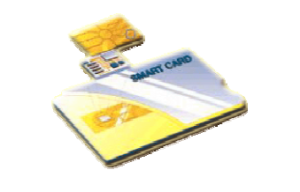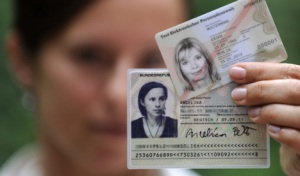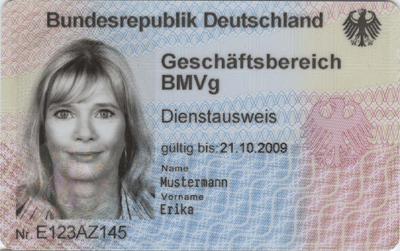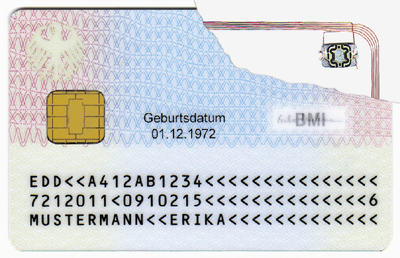Διαφημίσεις
Άς παρουμε μία πρώτη ιδέα τού τρόπου ανάγνωσης τής RFID Κάρτας τού Πολίτη, μέ χρήση τού RFID – Reader( Άναγνωστης) ISO 14443.
‘Η νέα RFID Κάρτα θά περιέχει βιομετρικά στοιχεία τού κατόχου, δακτυλικά άποτυπώματα(fingerprints).
Θά έχει έπιπρόσθετες λειτουργίες δυνατότητες συναλλαγής μέσα στό Διαδύκτιο (Internet). Αυτό συμβαίνει γιατί οί πληροφοριές πού είναι τυπωμένες στήν κάρτα – ταυτότητα, είναι επίσης άποθηκευμένες στό Chip πού είναι ένσωματωμένο μέσα στήν κάρτα.
Γία πρώτη φορά ό κάτοχος τής κάρτας θά μπορεί νά κάνει χρήση της, γιά νά αποδείξει τήν ταυτότητα του μέσα στό διαδύκτιο (Internet).
Έκτός από τήν σέ απευθείας σύνδεση μέ τό Internet λειτουργία απόδειξης τής ταυτότητας του (id function), όπου πολίτες, έταιρίες καί δημόσιοι οργανισμοί θά άποδυκνείουν τήν ταυτότητα τους μέσα στό Internet, ό κάτοχος θά μπορεί νά επιλέξει τήν Λειτουργία τής Πιστοποιημένης Ήλεκτρονικής Ύπογραφής (Qualified Electronical Signature – QES).
‘H Κάρτα RFID τού Πολίτη είναι Ύβριδική (hybrid card), ανήκει δηλαδή στήν κατηγορία Έξυπνων Καρτών (smart cards)πού έχουν ενσωματωμένα 2 Microchips. !!! Ένα Άσύρματο Microchip Μνήμης (contactless memory chip) καί ένα Microchip έπαφής μέ έπεξεργαστή (contact processor chip) .!!!
(Δείτε τήν κάτω φωτογραφια. Τό ασύρματο microchip είναι στην δεξιά πάνω μεριά, καί τό microchip έπαφής στά αριστερά).
ΠΑΡΑΡΤΗΜΑ
Έξυπνες Κάρτες (Smart Cards)
1.Τί έιναι
Οι έξυπνες κάρτες είναι ουσιαστικά μικροσκοπικοί υπολογιστές, που έχουν το μέγεθος και τη φόρμα μίας πιστωτικής κάρτας, πάνω στην οποία είναι ενσωματωμένο ένα ολοκληρωμένο κύκλωμα (chip), στην εμπρόσθια αριστερή πλευρά.
 Το ολοκληρωμένο κύκλωμα (microchip) περιέχει τις επαφές εισόδου-εξόδου και μπορεί να περιέχει μόνο μνήμη (memory) ή καιμικροεπεξεργαστή (microprocessor). Το ολοκληρωμένο κύκλωμα μπορεί να παρέχει μία ασφαλή δομήπολλαπλών επιπέδων και να επιτρέπει ιεραρχημένη πρόσβαση, καθιστώντας δύσκολη τηνπρόσβαση στα στοιχεία και την παραποίηση αυτών, να υπολογίζει κρυπτογραφικές συναρτήσεις (cryptographic functions) και να αντιλαμβάνεται άμεσα προσπάθειες πρόσβασης, οι οποίες δεν είναι έγκυρες όπως για παράδειμα το κλείδωμα της κάρτας SIM σε περίπτωση εισαγωγής λανθασμένου PIN περισσότερες από τρεις –συνήθως-φορές.
Το ολοκληρωμένο κύκλωμα (microchip) περιέχει τις επαφές εισόδου-εξόδου και μπορεί να περιέχει μόνο μνήμη (memory) ή καιμικροεπεξεργαστή (microprocessor). Το ολοκληρωμένο κύκλωμα μπορεί να παρέχει μία ασφαλή δομήπολλαπλών επιπέδων και να επιτρέπει ιεραρχημένη πρόσβαση, καθιστώντας δύσκολη τηνπρόσβαση στα στοιχεία και την παραποίηση αυτών, να υπολογίζει κρυπτογραφικές συναρτήσεις (cryptographic functions) και να αντιλαμβάνεται άμεσα προσπάθειες πρόσβασης, οι οποίες δεν είναι έγκυρες όπως για παράδειμα το κλείδωμα της κάρτας SIM σε περίπτωση εισαγωγής λανθασμένου PIN περισσότερες από τρεις –συνήθως-φορές. Αρκετοί από εμάς χρησιμοποιούμε ήδη μία ή περισσότερες έξυπνες κάρτες στην καθημερινή μας ζωή. Για παράδειγμα, έξυπνη κάρτα είναι η κάρτα SIM που χρησιμοποιείται στο σύστημα κινητής τηλεφωνίας GSM.
.
2. Ίστορία τών καρτών
.
Οι πρόγονοι των έξυπνων καρτών θεωρούνται οι πιστωτικές κάρτες που εξέδωσε ο οργανισμός Diners Club τη δεκαετία του 1950. Οι κάρτες αυτές είχαν το μέγεθος μίας επαγγελματικής κάρτας (business card)και είχαν τυπωμένο το όνομα του κατόχου της στην εμπρόσθια όψη. Η επίδειξητης ήταν αρκετή, ώστε ο πάροχος της υπηρεσίας (π.χ. ξενοδοχείο ή εστιατόριο) να παράσχει πίστωση στον κάτοχό της. Με τον τρόπο αυτό διευκολύνθηκαν τα επαγγελματικά ταξίδια.
Αργότερα, η εκτύπωση του ονόματος γινόταν σε ανάγλυφο (όπως για παράδειγμα σήμερα στις κάρτες ανάληψης χρημάτων από τα ΑΤΜ των τραπεζών), ώστε να διευκολύνεται η αποτύπωσητου ονόματος του κατόχου. Μερικά χρόνια αργότερα οι κάρτες αυτές απέκτησανμία μαγνητική λωρίδα (magnetic stripe), η οποία επέτρεπε τη μηχανική αποτύπωση των στοιχείων του κατόχου.Με τον τρόπο αυτό η επεξεργασία των στοιχείων μπορούσε να γίνει ηλεκτρονικά, επιταχύνοντας τις συναλλαγές. Παρέμενε όμως το πρόβλημα της απάτης,καθώς οποιοσδήποτε, έχοντας τον κατάλληλο εξοπλισμό, μπορούσε να δημιουργήσει πλαστές κάρτες.
Θα μπορούσαμε να πούμε ότι οι έξυπνες κάρτες είναι το αποτέλεσμα της ταυτόχρονης βελτίωσης των πλαστικών καρτών και τωνmicrochip. Το 1969 παρουσιάστηκε στη Γαλλία, από τον δημοσιογράφο Roland Moreno, μία ιδέα για μία κάρτα με ενσωματωμένο κύκλωμα (microchip). Έτσι γεννήθηκε η έξυπνη κάρτα. Οι έξυπνες κάρτες αναπτύχθηκαν ανεξάρτητα στη Γερμανία (1967), στην Ιαπωνία (1970) και στις Η.Π.Α. (1972). Οι έξυπνες κάρτες άνθισαν τη δεκαετία του 1980.Στο διάστημα 1982-84 η Cartes Bancaire (Ένωση Τραπεζικών Καρτών της Γαλλίας) έτρεξε το πρώτο πιλοτικό πρόγραμμα για έξυπνες κάρτες. Η Ένωση συνεργάστηκε με τις εταιρείες Bull,Philips και Schlumberger κάνοντας δοκιμές στις Γαλλικές πόλεις Blois, Caen και Lyon. Οι δοκιμές είχαν τεράστια επιτυχία και μόνο ελάσσονα προβλήματα. Μία βελτίωση που προέκυψεαπό το πιλοτικό πρόγραμμα ήταν η ενσωμάτωση της μαγνητικής λωρίδας, ώστε να διατηρηθεί η συμβατότητα με τα τότε υπάρχοντα συστήματα.
Μετά την πολύ πετυχημένη δοκιμή, οι Γαλλικές τράπεζες εισήγαγαν τη χρήση των έξυπνων καρτών για τραπεζικές λειτουργίες στο ευρύ κοινό. Η χρήση αυτή είναι το πρώτο παράδειγμα δημόσιας λειτουργίας των έξυπνων καρτών για τραπεζικές λειτουργίες. Παράλληλα,έγινε μία μεγάλη διαφημιστική εκστρατεία, οπότε και καθιερώθηκε ο όρος «έξυπνη κάρτα» (smart card).
3. Είδη έξυπνων καρτών
.
Στις μέρες μας, οι έξυπνες κάρτες μπορούν να κατηγοριοποιηθούν με δύο βασικά κριτήρια : επεξεργαστική ικανότητα και δυνατότητες εισόδου εξόδου.
Με βάση το πρώτο κριτήριο ίκανότητα έπεξεργασίας, διακρίνουμε τρεις κατηγορίες έξυπνων καρτών:
1. Κάρτες μνήμης – κάρτες αποθήκευσης πληροφοριών (memory cards). Οι κάρτες αυτές περιέχουν κάποια μνήμη και λογική σε υλικό (hardware logic), η οποία μπορεί να θέσει ή να διαγράψει τιμές στη μνήμη. Οι κάρτες μνήμης αναφέρονται καταχρηστικά ως έξυπνες κάρτες, καθώς δεν έχουν δυνατότητα επεξεργασίας των δεδομένων.
2. Έξυπνες κάρτες (smart cards, IC cards, microprocessor cards). Είναι οι «κλασικές» έξυπνες κάρτες ή κάρτες μεμικροεπεξεργαστή,. Ο επεξεργαστής τους, πέρα από την αποθήκευση και ασφάλιση πληροφοριών, μπορεί να λαμβάνει αποφάσεις που ορίζονται στις προδιαγραφές του έργου για το οποίο θα χρησιμοποιηθούν.
3. Έξυπνες κάρτες πολλαπλών εφαρμογών (multi-application smart cards). Οι έξυπνες κάρτες τελευταίας γενιάς έρχονται με ανοικτά λειτουργικά συστήματα (Java, MULTOS) και μπορούν να εκτελούν περισσότερες από μία εφαρμογές. Παρέχεται επίσης η δυνατότητα στο χρήστη να «φορτώνει» νέες εφαρμογές, ή να διαγράφει άλλες ανάλογα με τις ανάγκες του.
14.03.2007
 Ή Γερμανική ‘Εταιρία Bundesdruckerei παρουσιάζει τήν Ευρωπαική ‘Ηλεκτρονική ID Κάρτα(European electronic ID card) – Ευρωπαική Κάρτα τού Πολίτη (European Citizen Card, ECC). ‘Η παρουσίαση έγινε στά πλαίσια τών ‘εγκαινίων στό Ανόβερο τής CeBIT (CEntrum der Βόro- und Ιnformationsτechnik = Κέντρο του γραφείου και της τεχνολογίας πληροφοριών)ITC (Ιnstrumental TransCommunication = Έργαστηριακή Άμφίδρομη Έπικοινωνία), τής μεγαλύτερης διεθνούς έκθεσης προϊόντων υψηλής τεχνολογίας. , όπου συμμετείχαν συνολικά 6.059 εκθέτες από 7 7 χώρες και η οποία ήταν ανοικτή στο κοινό έως τις 21 Μαρτίου. Στήν έκθεση παρουσιάστηκαν οί νέες γερμανικές High-Tech κάρτες ταυτότητας, μέ τίς όποιες έφοδιάζονται όλοι οί Γερμανοί Πολίτες από τήν 1η Νοεμβρίου 2010.
Ή Γερμανική ‘Εταιρία Bundesdruckerei παρουσιάζει τήν Ευρωπαική ‘Ηλεκτρονική ID Κάρτα(European electronic ID card) – Ευρωπαική Κάρτα τού Πολίτη (European Citizen Card, ECC). ‘Η παρουσίαση έγινε στά πλαίσια τών ‘εγκαινίων στό Ανόβερο τής CeBIT (CEntrum der Βόro- und Ιnformationsτechnik = Κέντρο του γραφείου και της τεχνολογίας πληροφοριών)ITC (Ιnstrumental TransCommunication = Έργαστηριακή Άμφίδρομη Έπικοινωνία), τής μεγαλύτερης διεθνούς έκθεσης προϊόντων υψηλής τεχνολογίας. , όπου συμμετείχαν συνολικά 6.059 εκθέτες από 7 7 χώρες και η οποία ήταν ανοικτή στο κοινό έως τις 21 Μαρτίου. Στήν έκθεση παρουσιάστηκαν οί νέες γερμανικές High-Tech κάρτες ταυτότητας, μέ τίς όποιες έφοδιάζονται όλοι οί Γερμανοί Πολίτες από τήν 1η Νοεμβρίου 2010. ‘Η νέα Κάρτα θά έχει τρεις λειτουργίες: 1. βιομετρική επαλήθευση ταυτότητας, 2. ηλεκτρονική επαλήθευση ταυτότητας, 3.επικύρωση ηλεκτρονικής υπογραφής.
Ή Γερμανική ‘Εταιρία Bundesdruckerei άναπτύσσει τή νέα γενία τών άνθεκτικών στήν παραποίηση ‘υψηλής ‘ασφαλειας καρτών.
02.04.2008
 Στήν έναρκτήρια ημέρα τής διεθνούς έκθεσης CeBIT στό Άνόβερο,ή έταιρία Bundesdruckerei παρουσιάζει τή νέα γενία τών άνθεκτικών στήν παραποίηση ύψηλής άσφάλειας καρτών, βασισμένων σέ υλικό από πολυάνθρακα (polycarbonate – PC), πού λέγεται “Innosec Fusion”. Διάφορες Εύρωπαικές χώρες συμπεριλαμβανομένης καί τής Γερμανίας, προγραμματίζουν νά εισάγουν τίς νέες ήλεκτρονικές κάρτες ταύτοτητες (ID), μέ ένα ένσωματωμένο Chip, στό άμεσο μέλλον.
Στήν έναρκτήρια ημέρα τής διεθνούς έκθεσης CeBIT στό Άνόβερο,ή έταιρία Bundesdruckerei παρουσιάζει τή νέα γενία τών άνθεκτικών στήν παραποίηση ύψηλής άσφάλειας καρτών, βασισμένων σέ υλικό από πολυάνθρακα (polycarbonate – PC), πού λέγεται “Innosec Fusion”. Διάφορες Εύρωπαικές χώρες συμπεριλαμβανομένης καί τής Γερμανίας, προγραμματίζουν νά εισάγουν τίς νέες ήλεκτρονικές κάρτες ταύτοτητες (ID), μέ ένα ένσωματωμένο Chip, στό άμεσο μέλλον. 14.12.2009
 ‘Ο Γερμανός Ύπουργός Έσωτερικών έπιβεβαίωσε ότι, οί νέες ταυτότητες – κάρτες πού περιέχουν Chip ραδιοσυχνότητας (RFID), θά αρχίσουν νά δίνονται άπό 1ης Νοεμβρίου τού 2010.!!
‘Ο Γερμανός Ύπουργός Έσωτερικών έπιβεβαίωσε ότι, οί νέες ταυτότητες – κάρτες πού περιέχουν Chip ραδιοσυχνότητας (RFID), θά αρχίσουν νά δίνονται άπό 1ης Νοεμβρίου τού 2010.!! Οί πληροφορίες θά άποθηκέυονται μέσα στό RFID Chip.
Θά υπάρχουν καί 2 ανιχνεύσεις δακτύλων (fingeprint scans), οποίες στήν αρχή θά είναι προαιρετικές.
Ή ταυτότητα θά περιέχει καί τήν ψηφιακή ύπογραφή τού κατόχου ( digital signature), πού θά μπορεί να χρησιμοποιηθεί γία νά διεκπεραιώσει επίσημες υποθέσεις καί δοσοληψίες μέ τά Κυβερνητικά γραφεία καί ενδεχομένως καί σέ περισσότερους τομείς τής ζωής του, έχοντας πρόσβαση μόνο από ένα 6ψηφιο άριθμό PIN.
Όι πολίτες επιλέγουν σέ ποιόν θέλουν νά δώσουν τά στοιχεία καί ποιά θα δώσουν, είπε ο επίσημος τού Ύπουργείου Έσωτερικών Hans Bernhard Beus.
Αλλά οί Συνήγοροι Προστασίας δεδομένων του πολίτη λένε ότι τό RFID Chip τό οποίο μπορεί νά άνιχνευτεί μέσω ραδιοσυχνοτήτων από απόσταση 2 μέτρων, χωρίς τήν γνώση τού κατοχου του, είναι προβληματικό, άν καί ήδη έχει ενσωματωθεί στά Γερμανικά διαβατήρια.
‘Ο καθηγητής Andreas Pfitzmann, προιστάμενος τής ομάδας άσφαλειας δεδομένων καί ιδιωτικότητας, στό Τεχνικό Πανεπηστήμιο τής Δρέσδης, δήλωσε ότι δέν υπάρχει κανένας λόγος νά χρησιμοποιηθούν RFIC chips, γία τίς ταυτότητες, καί στό χειρότερο σενάριο τά Chips, θά μπορούσαν νά χρησιμοποιηθούν στήν πραγματοποίηση εώς καί τρομοκρατικών επιθέσεων. !!! Ένα ακραίο παράδειγμα θά ήταν υποθετικά άν τά Γερμανικά διαβατήρια λειτουργούν διαφορετικά στήν ραδιοσυχνότητα από τά Άμερικάνικα, νά μυροδοτήσει καποιος μιά βόμβα εκεί πού ξέρει ότι είναι μόνο Γερμανοί ή Άμερικάνοι, δήλωσε. Ό Pfitzmann πού ειδικεύεται στήν διαχείρηση ιδιοτηκότητας καί ταυτότητας στήν Ευρώπη, μίλησε έναντίον τής χρήσης RFID e-passports ( Ήλεκτρονικών διαβατηρίων μέ Microchip), σέ Κοινοβουλευτικές άκροάσεις στά τέλη τής δεκαετίας τού 90.
Στην έκθεση CeBIT του 2010 έγινε και δημοσκόπηση, σε δείγμα χιλίων ανθρώπων, σύμφωνα με την οποία ένας Γερμανός στους τέσσερις δήλωσε έτοιμος να δεχθεί να του εμφυτευτεί υποδορίως ένας “ηλεκτρονικός κοριός” (chip) αν έχει κάποιο όφελος από αυτόν. !!!
Στη Γερμανία η ταυτότητα εκδίδεται κάθε δέκα χρόνια από το δημαρχείο ή τα παραρτήματά του, ενώ οι πολίτες είναι υποχρεωμένοι να δηλώνουν ενδιάμεσα κάθε αλλαγή κατοικίας ή οικογενειακής κατάστασης.Το κόστος είναι 8 ευρώ και η έκδοσή της διαρκεί 6 εβδομάδες.
Κατ’ αρχήν αντιπολίτευση και ειδικοί σε ζητήματα προσωπικών δεδομένων εκτιμούν ότι η εθελοντική καταγραφή των αποτυπωμάτων προκαλεί νέα προβλήματα, διότι χωρίζει τους πολίτες σε δυο κατηγορίες: Στους πρόθυμους και επομένως ‘αθώους’ και στους μη πρόθυμους, δηλαδή τους ‘ύποπτους’.
Ο νομικός Τίλο Βάιχερτ, ειδικός σε ζητήματα δεδομένων και πρόεδρος της Ένωσης για την Προστασία των Δεδομένων στη Γερμανία, επισημαίνει ότι με την αποθήκευση βιομετρικών στοιχείων αυξάνεται ο κίνδυνος πλαστογράφησης της ταυτότητας, γιατί είναι πια πολύτιμη: «Πρόκειται για μεγάλο κίνδυνο. Στις ΗΠΑ και στη Μεγάλη Βρετανία είναι ήδη γνωστό. Σε άλλες χώρες εκτός Γερμανίας η κλοπή ταξιδιωτικών και προσωπικών εγγράφων είναι πολύ διαδεδομένη και μια τέτοια ταυτότητα, εάν έχει και δακτυλικά αποτυπώματα, συνιστά κίνδυνο αύξησης της πλαστογράφησης εγγράφων και στη Γερμανία». Κάθε προσωπικό έγγραφο που εμπλουτίζεται με επιπλέον στοιχεία καθίσταται πολύτιμο για πλαστογράφους και τρομοκράτες.
Χαρακτηριστικό είναι όμως ότι οι Γερμανοί διπλωμάτες δεν θα διαθέτουν ταυτότητες και διαβατήρια με βιομετρικά στοιχεία, αλλά ούτε και προτρέπονται να αποθηκεύσουν τα δακτυλικά τους αποτυπώματα. Το ίδιο εξάλλου αποφάσισε και η Κάτω Βουλή στη Μεγάλη Βρετανία, μόνον που οι Βρετανοί ήταν πιο ειλικρινείς, διότι δήλωσαν ότι «τα βιομετρικά στοιχεία σε προσωπικά έγγραφα αυξάνουν τον κίνδυνο πλαστογράφησής τους». «Απαράδεκτο» δηλώνει ο Τίλο Βάιχερτ και σχολιάζει: «άρα οι πολιτικοί, που προσπαθούν να πείσουν τον πληθυσμό για την αξία των βιομετρικών στοιχείων, εάν πρόκειται για τους ίδιους, αναγνωρίζουν ότι αυτά εμπερικλείουν σοβαρότατο κίνδυνο.»
Τελικά δηλαδή οποιοδήποτε προσωπικό έγγραφο που εμπλουτίζεται με επιπλέον στοιχεία καθίσταται πολύτιμο για τους κάθε λογής εγκληματίες, αλλά και για τους τρομοκράτες. Στις ΗΠΑ έχει αρχίσει ήδη αυτή η συζήτηση. Ο Ειδικός σε ζητήματα προσωπικών δεδομένων υποστηρίζει ότι η συζήτηση αυτή πρέπει να ληφθεί σοβαρά υπ’ όψιν και στη Γερμανία: «Έχω την εντύπωση πως και στις ΗΠΑ ο σκεπτικισμός γύρω από αυτό το θέμα μεγαλώνει.Διότι πρέπει να κατανοήσουμε ότι δεν είναι μόνον ζήτημα προστασίας ευαίσθητων δεδομένων, αλλά και προς το συμφέρον της ασφάλειας. Νομίζω ότι πρέπει να ξανασκεφθούμε την επιστροφή μας στα κανονικά μη ηλεκτρονικά, χάρτινα έγγραφα». Οπότε τίθεται το ερώτημα γιατί εγκρίθηκαν οι νέες ηλεκτρονικές ταυτότητες ;
‘Η Έταιρία πού είναι υπεύθυνη γία τήν Κατασκευή τών Καρτών στήν Γερμανία, ή Bundesdruckerei , μάς δίνει στήν ίστοσελίδα της τά ακόλουθα στοιχεία γιά την Κάρτα RFID.
Η ΚΑΡΤΑ RFID TOY ΠΟΛΙΤΗ είναι ΥΒΡΙΔΙΚΗ (hybrid card), ανήκει δηλαδή στήν κατηγορία ΕΞΥΠΝΩΝ ΚΑΡΤΩΝ (smart cards)πού έχουν ενσωματωμένα 2 MICROCHIPS. !!! Ένα ΑΣΥΡΜΑΤΟ MICROCHIP MNHMHΣ (contactless memory chip) καί ένα MICROCHIP ΕΠΑΦΗΣ μέ ΕΠΕΞΕΡΓΑΣΤΗ (contact processor chip) .!!! (Δείτε τήν μεθεπόμενη φωτογραφια. Τό ασύρματο microchip είναι στην δεξιά πάνω μεριά, καί τό microchip έπαφής στά αριστερά).
‘Η νέα RFID Κάρτα θά περιέχει βιομετρικά στοιχεία τού κατόχου, ΔΑΚΤΥΛΙΚΑ ΑΠΟΤΥΠΩΜΑΤΑ(fingerprints). Θά έχει έπιπρόσθετες λειτουργίες ΔΥΝΑΤΟΤΗΤΑ ΣΥΝΑΛΛΑΓΗΣ ΜΕΣΑ ΣΤΟ ΔΙΑΔΥΚΤΙΟ (INTERNET). Αυτό συμβαίνει γιατί οί πληροφοριές πού είναι τυπωμένες στήν κάρτα – ταυτότητα, είναι επίσης άποθηκευμένες στό CHIP ΠΟΥ ΕΙΝΑΙ ΕΝΣΩΜΑΤΩΜΕΝΟ ΜΕΣΑ ΣΤΗΝ ΚΑΡΤΑ. ΓΙΑ ΠΡΩΤΗ ΦΟΡΑ Ο ΚΑΤΟΧΟΣ ΤΙΣ ΚΑΡΤΑΣ ΤΑΥΤΟΤΗΤΑΣ ΘΑ ΜΠΟΡΕΙ ΝΑ ΚΑΝΕΙ ΧΡΗΣΗ ΤΗΣ, ΓΙΑ ΝΑ ΑΠΟΔΕΙΞΕΙ THN TAYTOTHTA TOY ΜΕΣΑ ΣΤΟ ΔΙΑΔΥΚΤΙΟ (INTERNET).Έκτός από τήν σέ απευθείας σύνδεση μέ τό Internet λειτουργία απόδειξης τής ταυτότητας του (id function), όπου πολίτες, έταιρίες καί δημόσιοι οργανισμοί θά άποδυκνείουν τήν ταυτότητα τους μέσα στό Internet, ό κάτοχος θά μπορεί νά επιλέξει τήν ΛΕΙΤΟΥΡΓΙΑ ΤΗΣ ΠΙΣΤΟΠΟΙΗΜΕΝΗΣ ΗΛΕΚΤΡΟΝΙΚΗΣ ΥΠΟΓΡΑΦΗΣ (QUALIFIED ELECTRONICAL SIGNATURE – QEL).
Berlin, 16 March 2007 – Bundesdruckerei GmbH produces the electronic office ID card for Germany’s federal authorities. Starting in the summer of this year, this card shall be gradually introduced for the Federal Armed Forces. This may be followed by other federal authorities.
Bundesdruckerei developed the office ID card together with the Federal Criminal Police Office (BKA) and the Federal Office for Information Security (BSI). The card is made of a durable and long-lasting polycarbonateand is a state-of-the-art, secure hybrid card. It features both a contactless memory chip as well as a contact processor chip. The traditional public authority ID card now includes a host of additional electronic mechanisms which enabled the implementation of a multi-functional security concept.
The security card is produced at Bundesdruckerei and is optically personalised there in a central process using laser engraving. In order to ensure maximum protection against forgery and manipulation, various different security features are already integrated into the card body during the production process. For instance, the card features a number of tried-and-tested security printing methods, such as guilloche patterns, microtext or copy-resistant printing inks, just like those used for the German ID card. The integration of a contactless chipmeans that the card can also be used for access control systems or to record working time. The integrated contact chip has been prepared for various applications, such as the electronic signature. The actual saving of data on the chip is only carried out by an authorised employee at the public authority. Personal data that is particularly sensitive cannot be read out without the consent of the card holder.
The issuing authorities alone hence define the functionalities and infrastructure connection for the office ID card. Bundesdruckerei can support the public authorities if necessary during the setting up of the technical requirements and during the integration of suitable applications. Numerous pilot projects have been carried out prior to the introduction of the office ID card. Under the leadership of Bundesdruckerei, the card was already tested back in 2001/2002 with employees from the Federal Ministry of the Interior (BMI) and the Federal Office for Information Security (BSI). From 2003 to 2005, Bundesdruckerei conducted a pilot project titled “Personal key card for the Federal Armed Forces” which additionally tested the integration of electronic office /troop ID cards into existing public key infrastructures (PKI).
About Bundesdruckerei:
Bundesdruckerei GmbH Berlin is one of the world’s leading companies engaged in developing and supplying systems solutions for secure identification. In addition to passport and ID-card systems, the company supplies ID documents, high-security cards, document checking devices, security software along with trust center services to national and international customers. Bundesdruckerei GmbH also produces banknotes, postage and revenue stamps as well as electronic publications. With its subsidiaries BIS Bundesdruckerei International Services GmbH, D-TRUST GmbH and iNCO Sp. z o.o., Bundesdruckerei employs a staff of more than 1,400 worldwide. The company generated revenue of EUR 312 million in the 2005 financial year.
2. Security Documents Electronic office ID card Modernising Germany’s administration is one of the paramount infrastructure challenges of recent years and will remain so in the years to come. The measures designed to optimise administrative procedures have already been launched on a broad basis and are now to be pushed further ahead. To this effect, the Federal Ministry of the Interior commissioned Bundesdruckerei GmbH in co-operation with the Federal Office for Information Security and the German Federal Criminal Police Office to develop and produce office ID cards with enhanced security features for the staff at all federal authorities. The Federal Armed Forces has also adopted this approach.
Vast experience and comprehensive results formed the foundation of the planning process:
In a first pilot project over a 7-month period, a preliminary version of the electronic office ID card was successfully tested from November 2001 to June 2002 by a total of 100 employees at the Federal Ministry of the Interior and at the Federal Office for Information Security under the leadership of Bundesdruckerei GmbH.
In addition to this, Bundesdruckerei successfully conducted a pilot project titled “Personal key card for the Federal Armed Forces” (May 2003 – October 2005) for the Federal Office for Information Management and Information Technology of the German Armed Forces. 764 cards were issued to 633 participants in the pilot phase at 56 locations and successfully tested.
The new electronic office ID card uses state-of-the-art hybrid card technology in order to combine the functionalities of contactless memory chips with those of contact-based processor chips, making it possible for the first time to integrate numerous additional electronic mechanisms into the conventional ID card, thereby implementing a multi-functional security concept.
|
‘Η νέα RFID Κάρτα θά περιέχει βιομετρικά στοιχεία τού κατόχου, ΔΑΚΤΥΛΙΚΑ ΑΠΟΤΥΠΩΜΑΤΑ (fingerprints). Θά έχει έπιπρόσθετες λειτουργίες ΔΥΝΑΤΟΤΗΤΑ ΣΥΝΑΛΛΑΓΗΣ ΜΕΣΑ ΣΤΟ ΔΙΑΔΥΚΤΙΟ (INTERNET). Αυτό συμβαίνει γιατί οί πληροφοριές πού είναι τυπωμένες στήν κάρτα – ταυτότητα, είναι επίσης άποθηκευμένες στό CHIP ΠΟΥ ΕΙΝΑΙ ΕΝΣΩΜΑΤΩΜΕΝΟ ΜΕΣΑ ΣΤΗΝ ΚΑΡΤΑ. ΓΙΑ ΠΡΩΤΗ ΦΟΡΑ Ο ΚΑΤΟΧΟΣ ΤΙΣ ΚΑΡΤΑΣ ΤΑΥΤΟΤΗΤΑΣ ΘΑ ΜΠΟΡΕΙ ΝΑ ΚΑΝΕΙ ΧΡΗΣΗ ΤΗΣ, ΓΙΑ ΝΑ ΑΠΟΔΕΙΞΕΙ THN TAYTOTHTA TOY ΜΕΣΑ ΣΤΟ ΔΙΑΔΥΚΤΙΟ (INTERNET).Έκτός από τήν σέ απευθείας σύνδεση μέ τό Internet λειτουργία απόδειξης τής ταυτότητας του (id function), όπου πολίτες, έταιρίες καί δημόσιοι οργανισμοί θά άποδυκνείουν τήν ταυτότητα τους μέσα στό Internet, ό κάτοχος θά μπορεί νά επιλέξει τήν ΛΕΙΤΟΥΡΓΙΑ ΤΗΣ ΠΙΣΤΟΠΟΙΗΜΕΝΗΣ ΗΛΕΚΤΡΟΝΙΚΗΣ ΥΠΟΓΡΑΦΗΣ (QUALIFIED ELECTRONICAL SIGNATURE – QEL).
3. Security Documents

New ID card
New ID card
The new ID card was launched in Germany on 1 November 2010.
This card can do everything the old ID card could – and much more.As a handy document in credit-card format, the new ID card will continue to be used as so-called photo ID. But for those citizens who wish to make use of its additional functions, transactions on the Internet are set to become more convenient and secure. That’s because the information printed on the ID card is also digitally stored on the chip integrated into the card. For the first time ever, the holder can use the new ID card to prove his identity on the Internet. At the same time, however, he continues to have full control over the data. Apart from the online ID function, the holder of the new ID card can also elect to use the qualified electronic signature (QES). When it comes to the sovereign ID function, citizens can choose whether or not to have their fingerprints stored on the chip in the card. This establishes an even stronger link between the document and its holder.
This card can do everything the old ID card could – and much more.As a handy document in credit-card format, the new ID card will continue to be used as so-called photo ID. But for those citizens who wish to make use of its additional functions, transactions on the Internet are set to become more convenient and secure. That’s because the information printed on the ID card is also digitally stored on the chip integrated into the card. For the first time ever, the holder can use the new ID card to prove his identity on the Internet. At the same time, however, he continues to have full control over the data. Apart from the online ID function, the holder of the new ID card can also elect to use the qualified electronic signature (QES). When it comes to the sovereign ID function, citizens can choose whether or not to have their fingerprints stored on the chip in the card. This establishes an even stronger link between the document and its holder.
1. Bundesdruckerei GmbH produces electronic office ID card for Germany’s federal authorities
Gradual introduction for the Federal Armed Forces to start in summer Multi-functional security concept developed
Bundesdruckerei is a one-stop shop for comprehensive security know-how for the new ID card:
- The company produces the new ID card, one of the most secure ID documents in the world.
- It issues authorisation certificates for online service providers.
- The company operates its own eID Service at its high-security computer centres for the authentication of online service providers.
4.Bundesdruckerei and Gothaer Versicherungen offer online function for the new German ID card
Berlin-based high-security company provides authorisation certificates and eID Service
Berlin, 2 November 2010 – Gothaer Allgemeine Versicherung is the first company in Germany to be officially authorised by the Federal Administration Office (BVA) to use electronic proof of ID. At the same time, the company opted for the eID Service and authorisation certificates from Bundesdruckerei GmbH for the new online authentication function.
The new German ID card launched on 1 November 2010 comes with an additional electronic ID function which allows citizens, companies and public agencies to prove their identity on the Internet in a reliable manner.
Bundesdruckerei is supporting Gothaer Allgemeine Versicherung in its endeavours to use this innovation in its business processes. Based on the approval recently issued by BVA, Bundesdruckerei will now issue the insurance company with the necessary authorisation certificates that serve as electronic service provider ID. These certificates authorise the insurance company to read out personal data from the new ID card on condition that the customer has given his consent.
Bundesdruckerei’s eID Service ensures secure communication during the exchange of data. This eID Service runs in the background and assumes the role of a trustworthy mediator between the online service provider and the user. It also ensures that all the data is encrypted and signed for transmission and that the user and the service provider can at all times be identified without any doubt according to the principle of mutual authentication.
Gothaer believes that electronic proof of ID has a lot to offer. “As a participant in the centrally co-ordinated application test for the German national ID card, we have already been working hand-in-hand with Bundesdruckerei and have come to appreciate the company as a competent partner,” says project manager Eric Wiedemann from sales management at Gothaer. “That’s why we are also relying on Bundesdruckerei’s eID Service for real-time operations.” Gothaer customers will soon be able to use their new ID cards in order to enter into online contracts or to request preliminary insurance confirmation.
Ulrich Hamann, CEO of Bundesdruckerei GmbH, is convinced: “This and many other forms of co-operation in the context our new eID Service will allow citizens to rely on improved identity protection and comprehensively verified service provider data. This marks a huge step towards secure identities.”
5. New ID card

Security chip
Security chip
The new ID card contains a security chip. This is where the digital photo and the information visible on the document are stored, i.e., the data of the printed machine-readable zone (back), family name and nee, first name, doctoral degree, date and place of birth, photo, address, nationality, series number as well as thereligious name or pseudonym.
Anybody who wishes to additionally protect their ID card against misuse can have two fingerprints stored on the chip when they apply for their ID document. The photo combined with the fingerprint clearly identifies the ID card holder.
If requested, certificate information can be additionally stored on the chip in order to use a qualified electronic signature (QES).
In order to warrant complete data transparency for each and every citizen, all ID card offices have been equipped with reading devices that have been certified by the German Federal Office for Information Security (BSI). These readers can be used to display all the data stored on the chip.
6.New ID card
|
| 1) How to change from the old ID card to the new one? The new Law on Identification Cards came into effect on 1 November 2010. Since then, citizens can apply for the new document only. All the old ID cards will continue to be valid until they reach their expiry date. However, citizens can apply for a new ID card at any time.2) Do other countries already have similar documents? Yes, and these documents are becoming increasingly more widespread throughout the world. In the European Union, for instance, citizens in Belgium, Estonia, Finland, Italy, Austria, Portugal and Spain already have electronic ID cards. However, these cards, which are also referred to as citizen cards, are rooted in other technical infrastructures and therefore cannot be fully compared to the German system. 3) What does the new ID card cost?
Pursuant to the Federal Ministry of the Interior’s current fee ordinance, the new ID card costs ?28.80. A reduction is available for applicants under the age of 24: for a first-time application, they pay a reduced fee of ?22.80. 4) How long is the new ID card valid?
The new ID card is valid for ten years for document holders over the age of 24. The period of validity for younger document holders is six years. 5) Why is there a chip in the new ID card?
The chip is where the personal information, such as name, address and date of birth, is digitally stored and the document holder can make this information available for the online ID function. The additionally stored biometric data of the facial image (mandatory) and the fingerprints (voluntary) ensure that the document cannot be forged and guarantee that it can be used as a valid travel document in the Schengen territory. 6) Can the ID card holder check the data stored on the chip?
Yes. In order to warrant complete data transparency for each and every citizen, all ID card offices have been supplied with reading devices that have been certified by the German Federal Office for Information Security (BSI). Agency staff can use these modules to display all of the personal data stored on the chip, including the digital passport photo and the fingerprints, if stored. 7) Why does the user need a PIN?
In order to use the online ID function, citizens can rely on their six-digit PIN (personal identification number) to release the document data for transmission to authorised service providers, for instance, for online shopping. Nothing happens the first time. If entered a second time, the card holder is requested to enter his six-digit access number which is visible on the front of the document. If the wrong PIN is entered three times, the PIN is disabled. In this case, the user can reset the incorrect-use counter by entering his PUK. This number can be used no more than ten times. After this, the citizen can no longer reactivate the PIN himself. Instead, the card holder must go to the ID card office where he can have a new PIN set. This is subject to a fee. 9) What is the purpose of storing fingerprints?
The additional storage of two fingerprints on the security chip of the new ID card is solely a voluntary decision and is used exclusively for sovereign ID functions. This feature allows citizens to identify themselves during sovereign border controls and in their own country, for instance, in dealings with the police. Just like the digital photo, the stored biometric fingerprint data strengthens the link between the ID document and its holder. This reduces the risk of identity misuse. 10) Who is authorised to read out fingerprints?
Only officially authorised bodies, such as the ID-card and passport offices, police enforcement authorities and the customs administration are permitted to read out biometric data pursuant to German data protection legislation. The data forms part of the sovereign ID function. Service providers cannot read out the biometric data within the scope of the online ID function. 11) What happens if an ID card holder does not want to give his fingerprints?
Nothing at all. The fingerprint data is only included in the document when explicitly requested by the citizen. If a citizen does not want this, the new ID card is then issued with all the options for electronic ID but without fingerprint data in the chip. 12) Where are the fingerprints stored?
The fingerprint data remains at the ID card office until the citizen collects his new ID card. The data is then irrevocably deleted and is now only stored on the security chip of the ID card. Bundesdruckerei, which produces the new ID card, does not store the fingerprints either. It is not permitted in Germany to store ID card data. 13) How can the ID card holder sign online using the new signature function?
The new ID card has been prepared for use with the qualified electronic signature (QES) which is legally equivalent to a hand-written signature. Citizen can use the signature function of their new ID card when they have a valid signature certificate. 14) How can citizens obtain a valid signature certificate?
Signature certificates are exclusively available from specialised trust centers or certification service providers (CSPs) and not from the ID card offices. Costs differ here depending on the provider. A list of providers is available on the website of the Federal Network Agency at: www.nrca-ds.de, under “Akkreditierte ZDA” [Accredited CSPs]. In order to integrate a signature certificate, the online ID function of the new ID card must be active. Citizens also need an advanced reader with an integrated PIN pad. 15) What happens to the qualified electronic signature (QES) if the ID card is lost?
The loss of a new ID card with an activated signature function must be reported immediately to the respective trust center so that the applications booked can be revoked. The local ID card offices are not responsible for revoking the signature function even when the ID card holder reports the loss to his office |
(ΣΥΝΕΧΙΖΕΤΑΙ)
Ή Γερμανική ‘Εταιρία Bundesdruckerei παρουσιάζει τήν Ευρωπαική ‘Ηλεκτρονική ID Κάρτα (European electronic ID card) – Ευρωπαική Κάρτα τού Πολίτη (European Citizen Card, ECC).
Οι κάρτες με μικροεπεξεργαστή, εκτός από CPU, διαθέτουν μνήμη ROM για την αποθήκευση του λειτουργικού συστματος της κάρτας, μνήμη RAM για γρήγορη εκτέλεση υπολογισμών και μνήμη EEPROM για την αποθήκευση εφαρμογών και δεδομένων. Πρόκειται ουσιαστικά για ολοκληρωμένους μικροσκοπικούς Η/Υ, οι οποίοι στερούνται μόνο συσκευών εισόδου/εξόδου.Έτσι προκειμένου να επικοινωνήσουμε με τους υπολογιστές αυτούς χρησιμοποιούμε τις συσκευές αποδοχής έξυπνων καρτών (card readers).
Μία δεύτερη κατηγοριοποίηση αφορά τον τρόπο επικοινωνίας των έξυπνων καρτών με το εξωτερικό περιβάλλον. Με βάση αυτό το κριτήριο, διακρίνουμε τις εξής κατηγορίες:
1. Έξυπνες κάρτες με επαφές (Contact Cards). Οι κάρτες αυτές επικοινωνούν με ηλεκτρικές επαφές και πρέπει να εισαχθούν σε μία συσκευή ανάγνωσης προκειμένου να διαβαστούν ή να εισαχθούν πληροφορίες.
2. Ασύρματες έξυπνες κάρτες (Contactless Cards). Οι κάρτες αυτές έχουν ενσωματωμένη εσωτερικά μία μικροσκοπική κεραία και μπορούν να επικοινωνούν με μία κεραία λήψης χωρίς τη φυσική τους επαφή με κάποια συσκευή ανάγνωσης προκειμένου οι πληροφορίες να ανανεωθούν, να αλλάξουν ή να υποβληθούν σε επεξεργασία.
3. Υβριδικές κάρτες και συνδυασμένες κάρτες (Hybrid και Combination Cards). Οι κάρτες αυτές ενσωματώνουν και τους δύο τρόπους μετάδοσης και συνεπώς μπορούν να επικοινωνήσουν κατά περίπτωση είτε με ενσύρματο είτε με ασύρματο τρόπο.
πηγη
πηγη
Φιλε μου ο σημερινός εχθρός σου είναι η παραπληροφόρηση των μεγάλων καναλιών. Αν είδες κάτι που σε άγγιξε , κάτι που το θεωρείς σωστό, ΜΟΙΡΆΣΟΥ ΤΟ ΤΩΡΑ με ανθρώπους που πιστεύεις οτι θα το αξιολογήσουν και θα επωφεληθούν απο αυτό! Μην μένεις απαθής. Πρώτα θα νικήσουμε την ύπνωση και μετά ΟΛΟΙ ΜΑΖΙ τα υπόλοιπα.
Επιλεξτε να γινετε οι πρωτοι που θα εχετε προσβαση στην Πληροφορια του Stranger Voice










